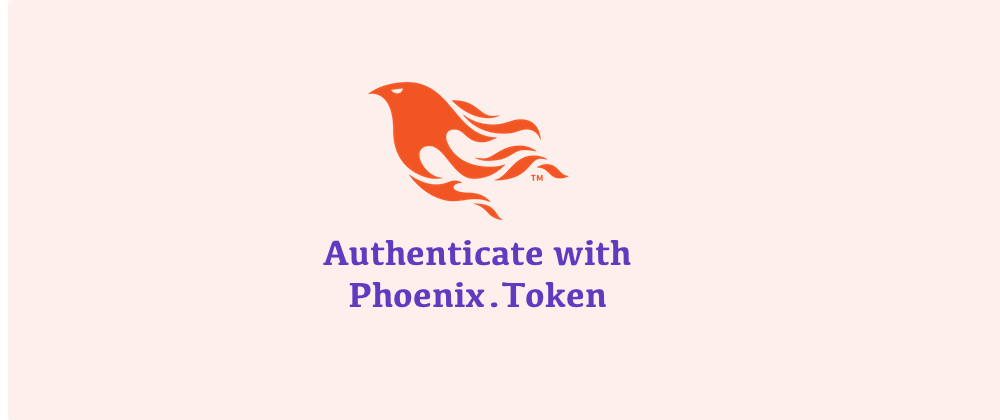In this post, you'll learn how to implement token based authentication using Phoenix.Token.
This is originally posted on The Orange+
In our previous projects, we use guardian library to implement JWT authentication. Guardian is a great library which provides lots of method and tool to work with authentication. But sometime we don't need them all. And recently, I found Phoenix.Token module shipped with phoenix framework that helps me to implement JWT alternative token authentication with few lines of code.
Let's do it.
1. Implement Token module
Here is the document of Phoenix.Token.
We just wrap sign and verify function from Phoenix.Token to create and check for valid token.
defmodule MyApp.Token do
@signing_salt "octosell_api"
# token for 2 week
@token_age_secs 14 * 86_400
@doc """
Create token for given data
"""
@spec sign(map()) :: binary()
def sign(data) do
Phoenix.Token.sign(MyAppWeb.Endpoint, @signing_salt, data)
end
@doc """
Verify given token by:
- Verify token signature
- Verify expiration time
"""
@spec verify(String.t()) :: {:ok, any()} | {:error, :unauthenticated}
def verify(token) do
case Phoenix.Token.verify(MyAppWeb.Endpoint, @signing_salt, token,
max_age: @token_age_secs
) do
{:ok, data} -> {:ok, data}
_error -> {:error, :unauthenticated}
end
end
end
Here we wrap in Token module to simplify API. We pass MyAppWeb.Endpoint here to use secret key that config for endpoint. You can pass secret key from config as firt argument.
2. Generate token
defmodule MyAppWeb.SessionController do
...
def new(conn, %{"email" => email, "password" => password}) do
with {:ok, user} <- Account.authenticate_user(email, password),
{:ok, token} <- MyApp.Token.sign(%{user_id: user.id}) do
...
# return token to client
else
_ ->
{:error, gettext("email or password is in correct")}
end
end
end
Here we create Phoenix token with a map %{user_id: user.id} and return to client.
3. Build Plug to verify token
Client sent token to server via header Authorization. We extract token and call Token.verify to check if token is valid and not expired.
defmodule MyApp.Plug.Authenticate do
import Plug.Conn
require Logger
def init(opts) do
opts
end
def call(conn, _opts) do
with ["Bearer " <> token] <- get_req_header(conn, "authorization"),
{:ok, data} <- MyApp.Token.verify(token) do
conn
|> assign(:current_user, MyApp.Account.get_user(data.user_id))
else
error ->
conn
|> put_status(:unauthorized)
|> Phoenix.Controller.put_view(MyAppWeb.ErrorView)
|> Phoenix.Controller.render(:"401")
|> halt()
end
end
end
4. Add plug to router
defmodule MyAppWeb.Router do
use MyAppWeb, :router
pipeline :api do
plug :accepts, ["json"]
end
pipeline :authenticated do
plug MyAppWeb.Plug.Authenticate
end
scope "/api", MyAppWeb do
pipe_through :api
post "/auth/login", SessionController, :new
end
scope "/api", MyAppWeb do
pipe_through [:api, :authenticated]
delete "/auth/logout", SessionController, :delete
...
end
end
We have done with it. Just a few line of code
Conclusion
Implement token authentication with Phoenix is so easy and you may not need Guardian for your application.
In this post I only implement simple version of token authentication. In real application, you should store token signature in database or redis and
- In
Authenticateplug check if the token exists in database. - When user logout, clear it from database/redis to make sure that token cannot be used to make request anymore.
Thanks for reading.
NOTES
If you want to known what is the different between JWT token and Phoenix.Token. Here is the answer from elixir forum
So, to answer the question: Phoenix.Token (with Plug Tokens) vs. JWT, several points I noticed:
Phoenix.Token doesn’t let you specify signing algorithms. JWT (for example using Joken 18) does.
Both encodes some form of payload into Base64, and the encoding can be read by clients (so you shouldn’t include sensitive information).
JWT allows you to encode arbitrary JSON objects as payload, Phoenix.Token uses Erlang terms serialization.







Top comments (2)
Good writup but JWT and Phoenix token similarity ends at them being kind of token. What you are doing is authentication with phoenix token not JWT authentication with phoenix token as both might be token but are not the same. A title update would make it clearer
elixirforum.com/t/how-is-phoenix-t...
Thank you very much for correcting me. I have updated the title and content to make it clear.